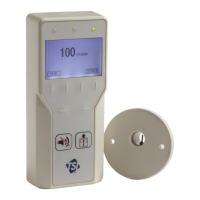Part Two
Software Programming
Programming the Model FHC50 controller is quick and easy if the programming keys are
understood, and the proper keystroke procedure is followed. The programming keys are defined
first, followed by the required keystroke procedure. At the end of this section is a programming
example.
NOTE: It is important to note that the unit is always operating (except when checking the
CONTROL OUTPUT) when programming. When a menu item value is changed, the new
value takes effect immediately after saving the change, not when the unit returns to
normal operating mode.
This section covers programming the instrument through the keypad and display. If
programming through network communications (see Appendix B), use the host computer’s
procedure. The changes take place immediately upon saving data in the instrument.
Programming Keys
The four vertical programming soft
keys (refer to Figure 3) are used to
program or configure the unit to fit your
particular application. Programming the
instrument will change how the unit
functions, so thoroughly review the
menu items to be changed.
Menu Soft Keys
The list below contains soft keys that will appear while in the menu structures.
The ESC soft key is used to escape from the current menu or menu item, and will also
cancel any change that is currently being made to an item value.
The / soft keys are used to scroll through the menus, menu items, and through the
range of item values that can be selected. Depending on the item type the values may
be numerical, specific properties (on/off), or a list of options.
NOTE: When programming a numerical menu item, continuously pressing the arrow
key will scroll through the values faster than if arrow key is pressed and
released.
The (ENTER) soft key performs three functions.
1. Provides access to specific menus and submenus.
2. Provides access to menu items.
3. Saves data.

